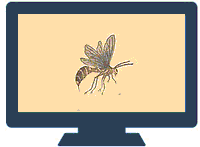Entomology, Department of

Department of Entomology: Distance Master of Science Projects
Date of this Version
8-10-2016
Document Type
Project
Citation
Entomology Distance Master’s Project, University of Nebraska-Lincoln, 2016
Abstract
Introduction
The Coachella Valley Mosquito and Vector Control District (CVMVCD) examined the activity of red imported fire ants, Solenopsis invicta, from May 2015 until May 2016. Ant abundance was measured to determine the most effective time for vector control technicians to conduct surveillance and to make treatments to control the ants. Since ants adapt and exploit their environment, the purpose of the study was to understand when the ants forage, so that the CVMVCD can manage the ants effectively. During the summer months, the temperatures can get up to as high as 120°F (49°C). These high temperatures are not safe for staff and so the work shifts are adjusted during the year. From May through September, technicians work from 5:30 a.m. to 2:00 p.m. and from October through April from 7:00 a.m. to 3:30 p.m. Since temperature is the driving force for insect development, growth, and behavior, under extreme hot and cold temperatures, insect growth and behavior is restricted. During winter, daytime temperatures can range from 68°F (20°C) to as high as 88°F (31°C) and the nights in the Coachella Valley can get as low as 30°F (1°C).
CVMVCD operates under the California Health and Safety code, Division 3, Sections 2000-2910 and covers 2,400 square miles. The District is located in Coachella Valley, southern California, and is a special district that protects the public health. It is a popular desert destination for tourists and snowbirds and has great weather almost year-round, except during the hot summer months. The valley's landscapes are man-made artificial oasis in a desert environment. Since the ants prefer a temperate, moist environment, daily irrigation to lawns, golf courses, and other horticultural landscapes in the Coachella Valley has provided ideal conditions for S. invicta to survive in an arid desert and establish.
Red imported fire ants (RIFA) are native to South America and were first introduced into the states at Mobile, Alabama, at about 1940. In California they were introduced in 1997–1998 when they were brought in on almond groves from Texas (Greenberg et al. 2002).They spread through the movement of soil and plants which was associated with commerce, either on vehicles, trucks, and trains. In California, RIFA is a quarantined pest. RIFA are holometabolous and mating flights allow the ants to colonize. The female alate mates, snaps her wings off, and finds a suitable place to begin a new colony and lay her eggs. The queen's wing muscles break down to provide the nutrients for the young larvae. The first workers burrow out of the chamber and forage for food to feed the new larvae and queen. The larvae are fed a liquid diet by trophallaxis until they reach the third instar. At the fourth instar stage, the larvae are able to eat and digest solid foods. The queen is fed to support egg production and can lay hundreds of eggs daily. The ants vary in size, and caste is determined by how much food is given to the larvae (Greenberg et al. 2002). The colonies are either monogyne or polygyne; having one queen or multiple queens per colony, respectively. When a mound is disturbed, RIFA emerge aggressively to bite and sting. The sting of the ant possesses venom of an alkaloid nature, which exhibits a potent necrotoxic activity (Collins and Scheffrahn 2001). It is a major agricultural and urban pest and nest in lawns, sidewalk edges, foundations, concrete driveways, and electrical boxes and can invade lawns, golf courses, parks, and school yards.
A component of the CVMVCD Integrated Vector Management program is to protect residents from the red imported fire ant, S. invicta. The program was established in 2005 to reduce the potential for injury and economic impact to the residents and visitors. The ants are aggressive and inflict a painful sting to animals and humans. Since the program began, the number of treatment applications made by District technicians to control the fire ants has increased in the Coachella Valley (Henke 2015). This increase in treatments could possibly be attributed to the ants spreading since the program began. Monitoring when the ants forage is necessary so that control efforts are successful at managing the ants. Thirty-two RIFA mounds were surveyed every two weeks during the time of day when District technicians were working. A hot dog slice was placed 3 ft. (1 m) from the mound for one hour. After one hour, the number of ants was estimated, the hot dog slice was removed, and a new hot dog slice was placed 90° from the previous location (for instance, if the first slice was north of the mound, the next slice was east of the mound). The lures were moved hourly so that the ants would follow a different trail of pheromones to the food. Air temperature and relative humidity were measured, and air temperature was found to be a good predictor of ant activity. The project examined ant abundance for one year during the summer, fall, winter, and spring. CVMVCD used this study to revise its Standard Operating Procedures to make effective and efficient treatments.


Comments
Copyright © 2016 Gabriela Harvey